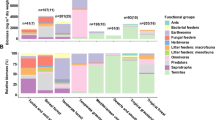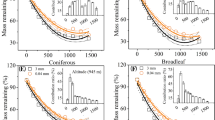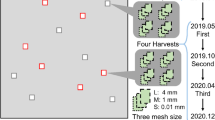Abstract
Aims
Soil fauna is one of the major drivers of plant litter decomposition. This study aims to assess how soil fauna density and diversity may affect litter decomposition. Also, we assessed whether faunal communities inside the litterbags that are used to control the access of faunal groups or communities in ambient soils are better for predicting their effects on litter decomposition, given that soil fauna frequently move into and out of such litterbags.
Methods
To answer this question, we synthesized 5336 observations extracted from 46 publications to assess the effects of soil fauna communities, their density and diversity on the rate of litter decomposition (k) and litter mass loss.
Results
Results showed that (1) the presence of soil fauna significantly increased k by an average of 33.0% and that the effects were mainly controlled by initial litter concentrations of phosphorus and magnesium, (2) the density and diversity of soil fauna in litterbags significantly affected k and/or mass loss, but ambient communities had limited effects, and (3) the effects of soil fauna in litterbags on k were most significant during the early stages of decomposition (0 − 30% mass loss).
Conclusions
Our study clearly showed that litterbag communities were better for predicting the effects of soil fauna on litter decomposition, and that their effects were most significant during the early stages of decomposition. These results improve our ability to estimate the contribution of soil fauna in liter decomposition and the associated carbon and nutrient cycling.




Similar content being viewed by others
Data availability
Raw data used in the study were deposited in figshare with a DOI (https://doi.org/10.6084/m9.figshare.21939557.v1).
References
Aerts R (1997) Climate, leaf litter chemistry and leaf litter decomposition in terrestrial ecosystems: a triangular relationship. Oikos 79:439–449
Barbier S, Gosselin F, Balandier P (2008) Influence of tree species on understory vegetation diversity and mechanisms involved—A critical review for temperate and boreal forests. For Ecol Manag 254:1–15. https://doi.org/10.1016/j.foreco.2007.09.038
Bates D, Mächler M, Bolker B, Walker S (2014) Fitting linear mixed-effects models using lme4. J Stat Softw 67:1–48
Berg B (2014) Decomposition patterns for foliar litter – A theory for influencing factors. Soil Biol Biochem 78:222–232. https://doi.org/10.1016/j.soilbio.2014.08.005
Berg B, McClaugherty C (2020) Plant litter: decomposition, humus formation, carbon sequestration. Springer Nature, Cham
Bluhm C, Butenschoen O, Maraun M, Scheu S (2019) Effects of root and leaf litter identity and diversity on oribatid mite abundance, species richness and community composition. PLoS One 14:e0219166
Bradford MA, Berg B, Maynard DS, Wieder WR, Wood SA (2016) Understanding the dominant controls on litter decomposition. J Ecol 104:229–238
Bradford MA, Veen G, Bonis A, Bradford EM, Classen AT, Cornelissen JHC, Crowther T, De Long JR, Freschet GT, Kardol P (2017) A test of the hierarchical model of litter decomposition. Nat Ecol Evol 1:1836–1845
Cebrian J (1999) Patterns in the fate of production in plant communities. Am Nat 154:449–468
Chassain J, VieubléGonod L, Chenu C, Joimel S (2021) Role of different size classes of organisms in cropped soils: What do litterbag experiments tell us? A meta-analysis. Soil Biol Biochem 162:108394. https://doi.org/10.1016/j.soilbio.2021.108394
Duval S, Tweedie R (2000) Trim and fill: a simple funnel-plot–based method of testing and adjusting for publication bias in meta-analysis. Biometrics 56:455–463
Egger M, Smith GD, Schneider M, Minder C (1997) Bias in meta-analysis detected by a simple, graphical test. BMJ 315:629–634
Frouz J (2018) Effects of soil macro- and mesofauna on litter decomposition and soil organic matter stabilization. Geoderma 332:161–172. https://doi.org/10.1016/j.geoderma.2017.08.039
Frouz J, Krištůfek V, Li X, Šantrůčková H, Šustr V, Brune A (2003) Changes in amount of bacteria during gut passage of leaf litter and during coprophagy in three species ofBibionidae (Diptera) larvae. Folia Microbiol 48:535–542
Frouz J, Jedlička P, Šimáčková H, Lhotáková Z (2015) The life cycle, population dynamics, and contribution to litter decomposition of Penthetria holosericea (Diptera: Bibionidae) in an alder forest. Eur J Soil Biol 71:21–27
García-Palacios P, Maestre FT, Kattge J, Wall DH (2013) Climate and litter quality differently modulate the effects of soil fauna on litter decomposition across biomes. Ecol Lett 16:1045–1053
García-Palacios P, McKie BG, Handa IT, Frainer A, Hättenschwiler S (2016a) The importance of litter traits and decomposers for litter decomposition: a comparison of aquatic and terrestrial ecosystems within and across biomes. Funct Ecol 30:819–829. https://doi.org/10.1111/1365-2435.12589
García-Palacios P, Shaw EA, Wall DH, Hättenschwiler S (2016b) Temporal dynamics of biotic and abiotic drivers of litter decomposition. Ecol Lett 19:554–563
Hättenschwiler S, Tiunov AV, Scheu S (2005) Biodiversity and litter decomposition in terrestrial ecosystems. Annu Rev Ecol Evol Syst 36:191–218
Jinggut T, Yule CM (2015) Leaf-litter breakdown in streams of East Malaysia (Borneo) along an altitudinal gradient: initial nitrogen content of litter limits shredder feeding. Freshwat Sci 34:691–701
Knollenberg WG, Merritt RW, Lawson DL (1985) Consumption of leaf litter by Lumbricus terrestris (Oligochaeta) on a Michigan woodland floodplain. Am Midl Nat 113:1–6
Koricheva J, Gurevitch J, Mengersen K (2013) Handbook of meta-analysis in ecology and evolution. Princeton University Press, Princeton and Oxford
Lin G, McCormack ML, Ma C, Guo D (2017) Similar below-ground carbon cycling dynamics but contrasting modes of nitrogen cycling between arbuscular mycorrhizal and ectomycorrhizal forests. New Phytol 213:1440–1451. https://doi.org/10.1111/nph.14206
Liu Y, Wang L, He R, Chen Y, Xu Z, Tan B, Zhang L, Xiao J, Zhu P, Chen L (2019) Higher soil fauna abundance accelerates litter carbon release across an alpine forest-tundra ecotone. Sci Rep 9:10561
Nakagawa S, Santos ES (2012) Methodological issues and advances in biological meta-analysis. Evol Ecol 26:1253–1274
National Research Council (2005) Mineral tolerance of animals. The National Academies Press, Washington DC
Peguero G, Sardans J, Asensio D, Fernández-Martínez M, Gargallo-Garriga A, Grau O, Llusià J, Margalef O, Márquez L, Ogaya R (2019) Nutrient scarcity strengthens soil fauna control over leaf litter decomposition in tropical rainforests. Proc R Soc B 286:20191300
Peng Y, Schmidt IK, Zheng H, Heděnec P, Bachega LR, Yue K, Wu F, Vesterdal L (2020) Tree species effects on topsoil carbon stock and concentration are mediated by tree species type, mycorrhizal association, and N-fixing ability at the global scale. For Ecol Manag 478:118510
Peng Y, Holmstrup M, Schmidt IK, Bachega LR, Schelfhout S, Zheng H, Heděnec P, Yue K, Vesterdal L (2022a) Tree species identity is the predominant modulator of the effects of soil fauna on leaf litter decomposition. For Ecol Manag 520:120396
Peng Y, Holmstrup M, Schmidt IK, De Schrijver A, Schelfhout S, Heděnec P, Zheng H, Bachega LR, Yue K, Vesterdal L (2022b) Litter quality, mycorrhizal association, and soil properties regulate effects of tree species on the soil fauna community. Geoderma 407:115570
Peng Y, Peñuelas J, Vesterdal L, Yue K, Peguero G, Fornara DA, Heděnec P, Steffens C, Wu F (2022c) Responses of soil fauna communities to the individual and combined effects of multiple global change factors. Ecol Lett 25:1961–1973
Prescott CE, Vesterdal L (2021) Decomposition and transformations along the continuum from litter to soil organic matter in forest soils. For Ecol Manag 498:119522
Rief A, Knapp BA, Seeber J (2012) Palatability of selected alpine plant litters for the decomposer Lumbricus rubellus (Lumbricidae). PLoS One 7:e45345
Singh J, Hundal J, Sharma A, Singh U, Sethi A, Singh P (2018) Phosphorus nutrition in dairy animals: A review. Int J Curr Microbiol App Sci 7:3518–3530
Suzuki Y, Grayston SJ, Prescott CE (2013) Effects of leaf litter consumption by millipedes (Harpaphe haydeniana) on subsequent decomposition depends on litter type. Soil Biol Biochem 57:116–123
Tordoff GM, Boddy L, Jones THJ (2006) Grazing by Folsomia candida (Collembola) differentially affects mycelial morphology of the cord-forming basidiomycetes Hypholoma fasciculare, Phanerochaete velutina and Resinicium bicolor. Mycol Res 110:335–345
Viechtbauer W (2010) Conducting meta-analyses in R with the metafor package. J Stat Softw 36:1–48
Wang Z (2016) Litter decomposition and the effects of soil fauna on litter decomposition and nutrient release in the coniferous forest of the Changbai Mountains, China. Norheast Normal University, Changchun
Xu X, Thornton P, Potapov P (2014) A aompilation of global soil microbial biomass carbon, nitrogen, and phosphorus data. ORNL DAAC, Oak Ridge
Xu X, Sun Y, Sun J, Cao P, Wang Y, Chen HY, Wang W, Ruan H (2020) Cellulose dominantly affects soil fauna in the decomposition of forest litter: A meta-analysis. Geoderma 378:114620
Yang Y, Wu Q, Yang W, Wu F, Zhang L, Xu Z, Liu Y, Tan B, Li H, Zhou W (2020) Temperature and soil nutrients drive the spatial distributions of soil macroinvertebrates on the eastern Tibetan Plateau. Ecosphere 11:e03075
Yue K, García-Palacios P, Parsons SA, Yang W, Peng Y, Tan B, Huang C, Wu F (2018) Assessing the temporal dynamics of aquatic and terrestrial litter decomposition in an alpine forest. Funct Ecol 32:2464–2475
Yue K, Jarvie S, Senior AM, Van Meerbeek K, Peng Y, Ni X, Wu F, Svenning J-C (2020) Changes in plant diversity and its relationship with productivity in response to nitrogen addition, warming and increased rainfall. Oikos 129:939–952. https://doi.org/10.1111/oik.07006
Yue K, De Frenne P, Van Meerbeek K, Ferreira V, Fornara DA, Wu Q, Ni X, Peng Y, Wang D, Heděnec P, Yang Y, Wu F, Peñuelas J (2022) Litter quality and stream physicochemical properties drive global invertebrate effects on instream litter decomposition. Biol Rev 97:2023–2038. https://doi.org/10.1111/brv.12880
Funding
Y.P. was founded by the National Natural Science Foundation of China (32201342) and Natural Science Foundation of Fujian Province (2022J01642). K.Y. was financially supported by the National Natural Science Foundation of China (31922052 and 32271633). F.W. was supported by the National Natural Science Foundation of China (32171641). J.P. and G.P. were funded by the Spanish Ministry of Science grant PID2019-110521 GB-I00, the Catalan government grant SGR2017-1005, and the Fundación Ramón Areces grant CIVP20A6621.
Author information
Authors and Affiliations
Contributions
Y.P., and F.W. conceived the study. Y.P., Q.W., P.H., and K.Y. collected raw data. Y.P., K.Y., and F.W. performed the statistical analyses. Y.P., L.V., J.P., G.P., Q.W., P.H., K.Y., and F.W. wrote the first draft and contributed to thorough revisions of the manuscript.
Corresponding author
Additional information
Responsible Editor: Guiyao Zhou.
Publisher's note
Springer Nature remains neutral with regard to jurisdictional claims in published maps and institutional affiliations.
Supplementary Information
Below is the link to the electronic supplementary material.
Rights and permissions
Springer Nature or its licensor (e.g. a society or other partner) holds exclusive rights to this article under a publishing agreement with the author(s) or other rightsholder(s); author self-archiving of the accepted manuscript version of this article is solely governed by the terms of such publishing agreement and applicable law.
About this article
Cite this article
Peng, Y., Vesterdal, L., Peñuelas, J. et al. Soil fauna effects on litter decomposition are better predicted by fauna communities within litterbags than by ambient soil fauna communities. Plant Soil 487, 49–59 (2023). https://doi.org/10.1007/s11104-023-05902-1
Received:
Accepted:
Published:
Issue Date:
DOI: https://doi.org/10.1007/s11104-023-05902-1




